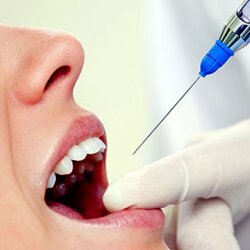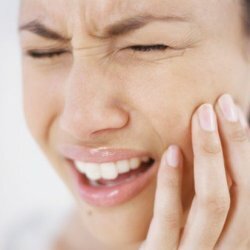How to choose a toothpaste for an adult?
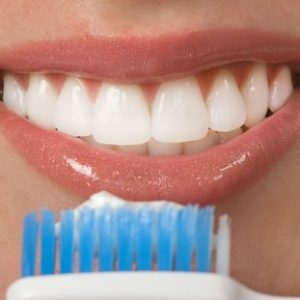 Most people are firmly convinced that choosing the right toothpaste is a very simple task.However, at present pharmacies and store chains offer such a wide choice of products that it is quite difficult to find their bearings in this variety.
Most people are firmly convinced that choosing the right toothpaste is a very simple task.However, at present pharmacies and store chains offer such a wide choice of products that it is quite difficult to find their bearings in this variety.
Advantages of toothpastes for adults
Modern toothpastes are the result of the improvement of older oral hygiene products - dental powders.The first toothpaste pastes were patented at the end of the 19th century, and the steel was widely used in the 30s of the last century.
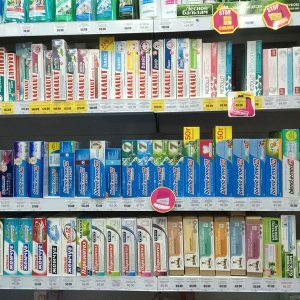 These hygiene products have a number of advantages over powders: they are more convenient to use, their packaging is compact, and the taste is incomparably better.The first toothpastes included crushed chalk( as an abrasive), glycerin, perfume oil, thickener( sodium salt of carboxymethylcellulose), foaming agent( sodium lauryl sulfate), as well as various fragrances to give a pleasant odor and preservative to extend shelf life.
These hygiene products have a number of advantages over powders: they are more convenient to use, their packaging is compact, and the taste is incomparably better.The first toothpastes included crushed chalk( as an abrasive), glycerin, perfume oil, thickener( sodium salt of carboxymethylcellulose), foaming agent( sodium lauryl sulfate), as well as various fragrances to give a pleasant odor and preservative to extend shelf life.
Later in the paste began to introduce biologically active substances that prevent the development of certain diseases and even fight a number of pathologies of the oral cavity.Thus, there were three main varieties of toothpastes for adults.
Classification of toothpastes
All such hygiene products can be conditionally divided into 2 categories: toothpastes for the intended purpose and toothpastes according to the method of application.
Pastes by design
It is currently accepted to distinguish three main groups of such toothpastes:
- Hygienic.
- Treatment and prophylactic.
- Therapeutic, complex.
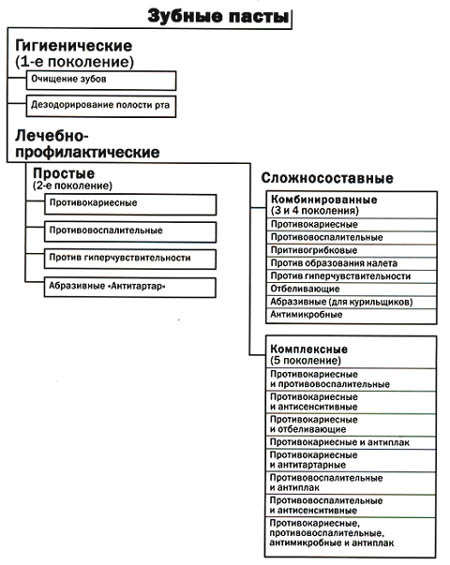
Hygienic toothpastes are used only for mechanical removal of soft plaque and food residues and refreshing( deodorizing) the oral cavity.They are shown in the complete absence of any diseases of the teeth, periodontal and mucous membranes and are intended for people with a high level of hygiene.Exceptionally hygienic pastes can now be bought only for children, since it is almost impossible to find an adult with absolutely healthy teeth.
The treatment and prophylactic products are designed to eliminate a number of factors that can eventually cause diseases of the teeth and periodontal tissues.In particular, pastes with a high content of fluorides strengthen the enamel, preventing the development of caries.
Therapeutic toothpastes contain active ingredients that affect certain pathological processes.As an example, the compositions with antifungal compounds for fighting candidiasis can be cited.
Types of curative and prophylactic toothpastes
Treatment and prophylaxis is a large group of pastes that can differ significantly in their composition and nature of the impact.
The following are distinguished:
- Pastes, positively affecting the mucous membranes and periodontal tissues.They can contain antiseptics, anti-inflammatory drugs, enzymes, mineral elements, enzymes, vitamins, extracts from medicinal herbs and other biologically active components( antioxidants and immunomodulators).As an abrasive they use aluminum hydroxide, and inflammation prevents or eliminates extracts of chamomile, St. John's wort, needle, sage and green tea.Anti-inflammatory pastes are shown, in particular, with gingivitis.
- Pastes affecting the mineralization of enamel.In them, manufacturers introduce hydroxyapatite calcium, fluoride compounds( usually sodium fluoride), salts of phosphorus, as well as various complexes of microelements.Means of this category are shown with a reduced content of fluoride in drinking water, as well as inadequate intake of calcium, violations of its digestibility or increased need for this macronutrient.
- Means preventing the formation of dental plaque . These include mineral salts, enzymes, fluoride compounds and antimicrobial components.
- Pastes for the prevention of the formation of hard mineralized deposits( tartar).For this purpose, pastes with a high content of abrasive particles are used.
- Paste for sensitive teeth( for example - Oral-B Sensitive) - may contain formalin, as well as compounds of strontium and potassium.
- Whitening toothpaste - contains abrasives, peroxide compounds( sodium borate), as well as ingredients that interfere with the crystallization process.
Please note: Whitening paste allows to slightly lighten the enamel for a long period of regular use, but does not replace professional bleaching, which can only be performed by a dentist.
Most modern dentifrice compositions are characterized by a combined action due to the fact that a variety of active components are included.Often, the same substance can be active against various pathological processes.
Thus, therapeutic and preventive pastes can be conditionally divided into two groups - combined and complex.The first consists of several active ingredients that have a similar effect.The second contain a "universal" therapeutic drug, which allows to prevent or slow the development of various pathological processes.
Therapeutic drugs that are part of toothpaste for adults
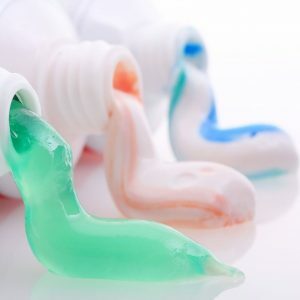 Some pastes of domestic production contain an extract of kelp - seaweed, also known as "sea kale."Extract is characterized by pronounced reparative( restorative) and immunostimulating properties.It helps to reduce inflammation, accelerate the regeneration of the damaged mucosa and normalize the periodontal state.
Some pastes of domestic production contain an extract of kelp - seaweed, also known as "sea kale."Extract is characterized by pronounced reparative( restorative) and immunostimulating properties.It helps to reduce inflammation, accelerate the regeneration of the damaged mucosa and normalize the periodontal state.
Nettle extract promotes deeper penetration of useful components into the periodontium, due to which the inflammatory processes became possible to be cut in the shortest possible time.
As antibacterial components, substances such as chlorhexidine, triclosan and metronidazole may be included in the paste formulation.Chlorhexidine is a powerful antiseptic, but a fairly long use of pastes with this component can lead to a change and decrease in taste sensitivity, as well as the dyspigmentation of the enamel.
Most often in modern pastes include triclosan, which is perfectly compatible with other ingredients, and can not cause allergy development.Metronidazole selectively affects some representatives of pathogenic microflora;It is part of some medicinal pastes.
Classification of pastes according to the application method
Tooth pastes for adults and children can be divided into:
- toothpaste for daily dental care( hygienic and therapeutic);
- pastes for single use or for use at specific time intervals( curative and preventive).
Please note: The whitening paste is intended for one-time use only because it contains a large number of abrasive particles.Regular use of such drugs can cause the thinning of enamel.
At present a number of companies also offer gels to consumers' attention, intended for application to the surface of enamel, which has been cleaned from plaque.They are used as an additional means of hygiene to prevent demineralization of dental tissues and to prevent inflammation of the gums and periodontium.They contain fluorine compounds( in high concentrations) and( or) enzymes and antibacterial components.
The basic requirements that toothpastes for adults must meet
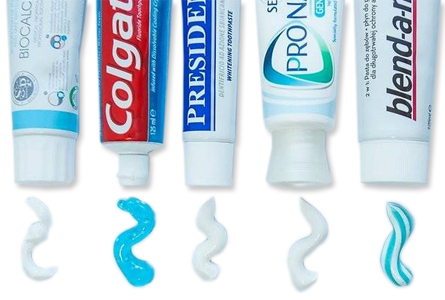
When choosing pastes, you need to pay attention to several criteria:
- Really high-quality pastes should well refresh the oral cavity, qualitatively remove the soft coating and have a pleasantTaste.
- As a result of their use, a person should not develop allergic reactions or local irritation of the mucous membranes.
- The stability and homogeneity( uniformity) of the composition is also a necessary requirement.
- Paste must contain components that prevent the reproduction of bacteria during storage and use of these hygiene products.
Recommendations and Warnings
To prevent the development of caries, it is recommended to use toothpastes with a high content of calcium salts, providing strength of enamel and fluorides, which form a protective layer and prevent leaching of inorganic components.
If carious lesions already take place, then it is better to apply paste without fluorine, because they can not stop the development of the disease, and the process can not be exacerbated.
Natural mineralizing properties of saliva improve with the use of complex therapeutic and prophylactic pastes, which include sodium monofluorophosphate.To strengthen hard tissues in the composition often include hydroxyapatite calcium, which is the ready "building material" for enamel.
Please note: Pasta as such can not completely eliminate the development of caries.The competent choice of a toothbrush and observance of a correct technique of cleaning of teeth is of great importance!
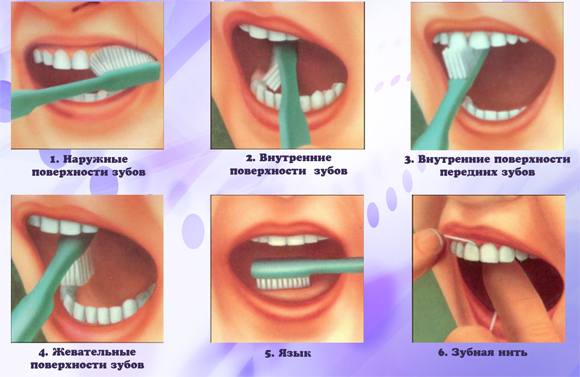
Against already formed mineralized deposits, pastes are useless, but products containing pyrophosphates reduce the risk of their formation by half!
Pasta without fluorine is shown to people living in areas where this element is in sufficient quantity in the running water used for drinking and cooking.An excess of fluorides can cause fluorosis, the main clinical manifestation of which is the appearance of "chalk" or pigmented( yellowish) spots and bands on the surface of the enamel.Those who live in the areas of the so-called."Endemic fluorosis", it is possible to recommend pastes with a high content of calcium compounds, but without fluorides( Oral-B Sensitive and Colgate Calcium).
Salt pastes are advisable to use in the lesions of periodontal tissues and periodontal.Mineral salts improve local blood circulation and stimulate metabolic processes.
The sensitivity of enamel is significantly reduced if using a paste with a low abrasive index, but containing chloride or potassium nitrate, as well as strontium chloride.
Whitening pastes should be used with caution and not every day.They can lead to a decrease in the strength of the enamel.
Please note: Bleached hard tooth tissues are easily colored by the action of pigments present in coffee, tea, berries, red wine and some vegetables!
Therapeutic paste can be used only on the advice of a dentist.They contain enzymes and biologically active components that serve to treat certain pathologies of the oral cavity.
Pastes with a high content of sodium bicarbonate( food soda) are able to create an alkaline environment that neutralizes the effect of acids( including those produced by microorganisms).High pH is maintained for 15-20 minutes after the end of hygiene procedures.The hypertensive environment helps to reduce swelling of the gums against the background of gingivitis.Soda provides excellent cleaning of the enamel, although it does not have an abrasive effect.Sodium bicarbonate is characterized by bactericidal activity against bacteria Streptococcus mutans, whose vital activity is considered one of the leading etiological factors in the development of carious lesions of teeth.

Do not blindly trust commercials and flashy labels on packages.
Important: Only the dentist can select the optimum paste suitable for you after a routine examination of the oral cavity.You should visit a doctor at least once every six months!
The specialist is able to objectively assess the level of hygiene and identify the presence of certain diseases, as well as predispositions to them.In accordance with the condition of teeth and mucous membranes of the oral cavity, the dentist will give recommendations on the choice of paste.
Remember that it is advisable to purchase hygiene products only in pharmacies or other specialized outlets;Otherwise the risk of buying counterfeit products is high enough.
Recommendations for the selection of toothpaste.Video:
Plisov Vladimir Alexandrovich, dentist


